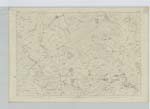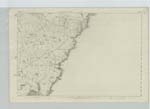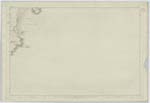OS1/1/22/2
| List of names as written | Various modes of spelling | Authorities for spelling | Situation | Description remarks |
|---|---|---|---|---|
| CRUDEN | Statistical Account. Valuation Roll. Revd. Dr. [Reverend Doctor] Pratt's history of Buchan. The Earl of Erroll Collections of the Shires |
031 ; 032 ; 039 ; 040 | [Continued from page 1] in the south end of the parish are composed chiefly of mica slate, and in the north of Granite. About a mile north of Slains Castle is the famous 'Bullers of Buchan' with its magnificent natural arch forming the entrance to the "Pot", this place is well visited in the summer season, and is well worth a visit, especially if the visitor will hire a boat and enter the Pot, & some of the caves in the neighbourhood, the cave of Bomahoy in particular, this must be done to see the beauty of the coast. This parish presents a splendid field for the antiquarian, the principal antiquities are as follows. The remains of St Olavs Chapel on the links bordering the Bay of Cruden, on the supposed site of the battle between the Danes, under Canute, and the Scots under Malcolm II, which ended in the utter discomfiture of the former, and their final expulsion from Scotland. The Church was erected by Malcolm and it was surrounded by a graveyard, wherein were buried the Slain of both Armies. There are several graves which are pointed out to the visitor as the resting place of eminent men in the early ages, one situated a short distance westward of the remains of the above mentioned Chapel of St Olavs, is supposed to have been the burying place of the Crown Prince of Denmark of whom tradition states that he was slain in the battle of Cruden. There was a beautiful slab over this grave until about the middle of last Century. It is supposed to have been despoiled of various ornaments, and was afterwards removed to the parish Churchyard. There is also another in the northern part of the parish called the "Kings Grave". The Revd. Dr. [Reverend Doctor] Pratt says it lies east & west, measured 3 ft. [feet] 10 inches in length, 22 inches in width, and 25 inches in depth. How it got this name there is not even a single tradition to inform us. Cairns are very plentiful in this parish, in the northern parts of the parish on the tracts which are still lying waste. Small mounds or Cairns can be seen at every twenty or thirty yds. [yards]. Celts were rather plentifully distributed throughout the parish, among the principal we may mention 3 found by Mr. Hutcheon of Berry Moss, and 3 found by Mr. Johnson, Moreseat, in both cases the lots were each found in the trunks of trees, embedded in moss. 1 found on the farm of Nook, 2 found on the farm of Standing Stones & various others. In 1817 a neck chain, and Battle Axe were found in a small mound near the farm of Greenbrae, for particulars see description. In 1821 a stone coffin containing a human skull, several small bones, two urns and seven flint arrow heads, were found on the farm of Uppermill, and several years after, other graves were found near the same place. A stone coffin was also found on the High Law and another in the Silver Cairn, in the latter was an Urn containing calcined bones, There was a Druidical Circle at (Stones). There were several beacon hills with artificial mounds on them. They were the High Law, the Moat Hill, the most of the mounds are now removed. Note _ There is no portion of this parish detached, nor portion, or portions, of any other Parish within the boundary of this Parish. |
Continued entries/extra info
[Page] 2Transcribers who have contributed to this page.
CorrieBuidhe- Moderator, hastingleigh, Marilyn de Santos
Location information for this page.







